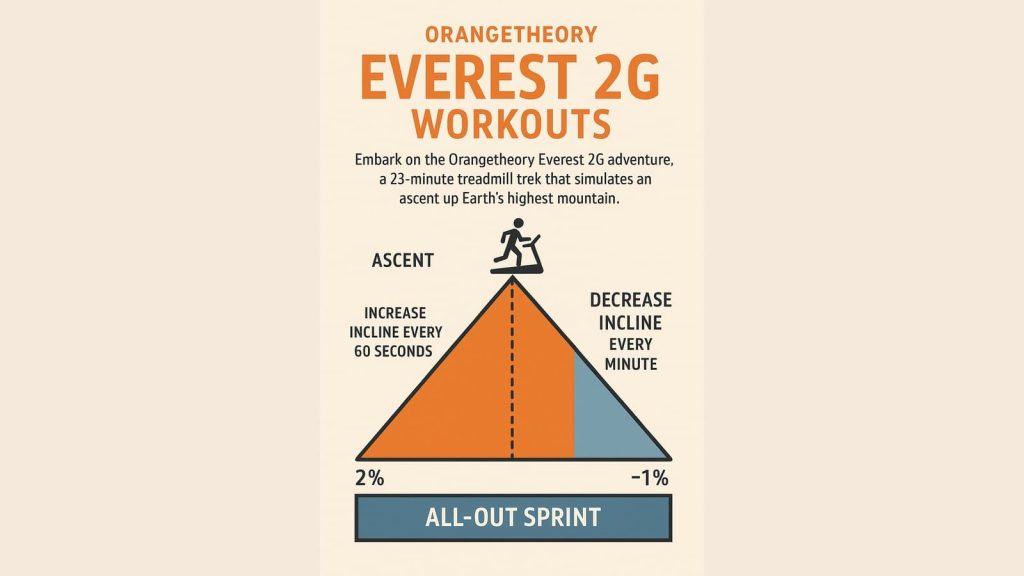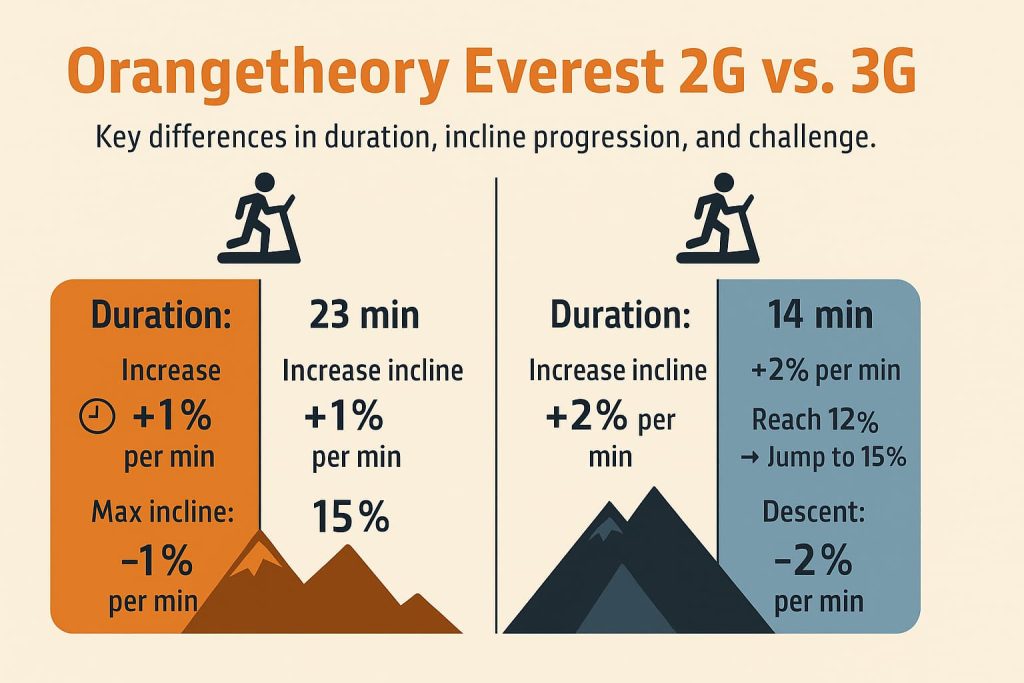
The Orange Everest Workout is a dynamic treadmill workout that simulates hill climbing with incline intervals. It commences with a moderate incline, typically starting at 2% for 2G and 3G sessions, and gradually increments by 1% each minute until it surges to a 15% grade – the zenith of this virtual Everest. After peaking, the journey downward begins, as participants gradually lower the incline.
The objective? To cover the greatest distance you can within the allotted time, all while maneuvering through the shifting incline terrain.
Orangetheory Everest 2G and 3G Workouts
Orangetheory Everest 2G Workouts

Embark on the Orangetheory Everest 2G adventure, a 23-minute treadmill trek that simulates an ascent up Earth’s highest mountain. The journey starts with a gentle 2% slope that incrementally increases every 60 seconds. This steady climb continues until you find yourself at a breathtaking 15% gradient.
After reaching this pinnacle, you’ll navigate a descending path, reducing the incline by 1% each minute. The grand finale is a high-energy, all-out sprint at a 1% decline, pushing you to your limits.
Orangetheory Everest 3G Workouts

The Everest 3G challenge is a compressed, high-intensity version of the workout. Lasting 14 minutes, the incline quickly ramps up by 2% each passing minute. This rapid ascent leads you to a challenging 12% slope before making the final push to a 15% summit.
Once you’ve triumphed over the peak, the descent begins at a 13% incline, decreasing by 2% every minute until reaching a manageable 1% gradient. Upon completing this intense treadmill session, you’ll transition to a combination of floor exercises and rowing to round out the full-body 3G class experience.
Orangetheory Everest 2G Vs. 3G classes?
Orange Everest 2G and 3G classes differ in duration and incline increments.

In a 2G class, the challenge spans about 23 minutes, with a 1% incline increase per minute, reaching 15% before descending to 14%.
Conversely, a 3G class lasts 14 minutes, escalating by 2% each minute until reaching 12%, then jumping to 15% before the decline phase begins.
Distance Goals for Orangetheory Everest 2G and 3G Workouts
Distance goals within the Orangetheory Everest Workouts are tailored to individual fitness levels and equipment choices, with specific benchmarks set for treadmill, bike, or strider workouts.
Orangetheory Everest 2G goals:
- Power Walkers aim for 1.4+ miles
- Joggers strive for 1.75+ miles
- Runners chase 2.0+ miles
- Bike Fanatics pedal to 7.0+ miles
- Strider Enthusiasts push for 5.3+ miles
Orangetheory Everest 3G goals:
- Power Walkers pursue 0.84+ miles
- Joggers reach for 1.05+ miles
- Runners go for 1.2+ miles
- Cyclists crank out 4.2+ miles
- Strider Aficionados achieve 3.18+ miles
When is Orangetheory Everest?
This stimulating Everest event is woven into the Orangetheory calendar about three times annually, offering members a quarterly test of their mettle.
Orangetheory Everest Workout Templates
Both Orangetheory Everest 2G and Everest 3G formats offer distinct experiences. A typical template might look like this:
Orangetheory Everest 2G Templates
| Treadmill block: 23 min 1 min starting at 2% incline basecamp foothills 1 min at 3% 1 min at 4% 1 min at 5% now we enter the mountain 1 min at 6% 1 min at 7% 1 min at 8% 1 min at 9% 1 min at 10% as we begin to see the snowcapped peaks 1 min at 11% 1 min at 12% 1 min at 13% 1 min at 14% 1 min at 15% we have arrived at the peak 1 min at 14% 1 min at 12% 1 min at 10% 1 min at 8% 1 min at 6% 1 min at 4% 1 min at 2% 1 min flat road 1 min all out | Floor block 1: 11 min 1 min strength row at 22-24 spm Bench plank row 6-10 reps Bench seated tricep extension 6-10 reps Alternating deadbug 12 reps Floor block 2: 12 min 1 min strength row at 22-24 spm Bench seated concentration curl 6-10 reps Bench seated hammer curls 6-10 reps Ab bicycle crunch 12 reps |
Orangetheory Everest 3G Templates
| Tread 14 minutes 1 min @ 2% 1 min @ 4% 1 min @ 6% 1 min @ 8% 1 min @ 10% 1 min @ 12% 1 min @ 15% 1 min @ 13% 1 min @ 11% 1 min @ 9% 1 min @ 7% 1 min @ 5% 1 min @ 3% 1 min All Out | Rower 14 minutes 500 m push row 12 each (yep- 24 total)- MB reverse lunge with bent arm torso rotation Repeat for 5 rounds, going down 100 m each round Row until 1 min AO row finisher | Floor 14 minutes 2 rounds 6-10 each x high plank single arm low row 6-10 x seated overhead tricep extension 12 total x alternating deadbug with press 2 rounds 6-10 each x single arm concentration curl 6-10 x seated hammer curl 12 total x bicycle crunch Repeat all exercises as one block until finisher Finisher 1 min bicycle crunch |
Orangetheory Everest Strategies and Tips
Tackling the Orangetheory Everest challenge requires not just physical endurance but also strategic planning. Here are some key strategies and tips to help you navigate the climb and enjoy the experience:
- Pacing Strategy: Kick off at your regular base pace. As the workout progresses and the incline starts to bite, be prepared to dial back your speed slightly. A good rule of thumb is to reduce your pace by around 0.2 mph for each level of increased incline to conserve energy and maintain a steady effort.
- Form Focus: Pay close attention to maintaining good posture throughout the climb. Keep your spine aligned and avoid hunching, particularly on the lower slopes. A fluid arm swing from elbow to hip can help maintain rhythm. As the incline intensifies, you may lean slightly into it, using your arms to propel you forward and ensuring your legs keep the momentum.
- Stride Regulation: Be mindful of where your feet land. Aim to keep your feet beneath your center of gravity to prevent overstriding, which is especially crucial when transitioning from climbing to descending.
- Adjusting Effort: For those new to the Everest challenge, or unsure of their ability to maintain a run throughout, alternating between a jog and power walk can be effective. This approach allows for recovery without stopping completely.
- Tracking Progress: The distance you cover will be logged, serving as a personal benchmark for future Everest challenges. Strive to improve upon your previous distance with each new attempt.
- Body Awareness: Listen to the cues your body gives you. Run when you’re feeling strong and switch to a power walk if you need to catch your breath. It’s about finding the right balance between pushing your limits and ensuring you can complete the challenge.
- Conquering the Peak: The final stretch at the highest inclines will test your resolve. Remember, as you overcome the toughest part, the descent will feel comparatively easier, and you may find yourself sprinting faster than expected as the incline decreases.
By employing these strategies, you’ll be well-equipped to face the Orangetheory Everest challenge head-on, ensuring you not only reach the summit but also enjoy the journey.
To Sum Up
The Orangetheory Everest Workout stands as an invigorating fitness pursuit, inviting members to master imaginary mountains and advance their physical prowess.
Newcomers and veterans alike will find the Everest Workout to be a rewarding venture, serving up diverse challenges to suit all fitness levels.
Gear up, welcome the ascent, and elevate your workout regime to unprecedented peaks with the Orangetheory Everest Workout.